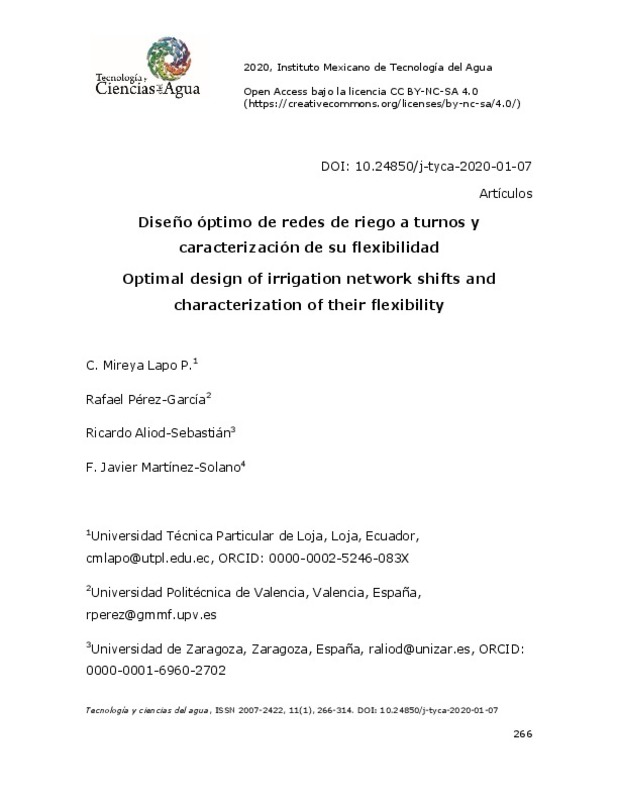JavaScript is disabled for your browser. Some features of this site may not work without it.
Buscar en RiuNet
Listar
Mi cuenta
Estadísticas
Ayuda RiuNet
Admin. UPV
Diseño óptimo de redes de riego a turnos y caracterización de su flexibilidad
Mostrar el registro sencillo del ítem
Ficheros en el ítem
| dc.contributor.author | Lapo P., C. Mireya
|
es_ES |
| dc.contributor.author | Pérez-García, Rafael
|
es_ES |
| dc.contributor.author | Aliod-Sebastián, Ricardo
|
es_ES |
| dc.contributor.author | Martínez-Solano, F. Javier
|
es_ES |
| dc.date.accessioned | 2021-02-16T04:32:10Z | |
| dc.date.available | 2021-02-16T04:32:10Z | |
| dc.date.issued | 2020-02 | es_ES |
| dc.identifier.uri | http://hdl.handle.net/10251/161382 | |
| dc.description.abstract | [EN] In this contribution, a nonlinear programming genetic hybrid algorithm for the optimal design of pressurized irrigation networks operating in shifts is presented, and an indicator is implemented to evaluate the flexibility of the resulting designs of the hybrid algorithm. The main objective is the minimization of the economic cost of the pipe network and the evaluation of the flexibility of the system designs. The research considers the allocation of shifts to the irrigation outlets (hydrants) and the sizing of the pipes as decision variables to reduce implementation costs. With the results of the optimization, the flexibility of the hydraulic network is analysed based on the random reassignment of shifts to the hydrants, which simulates the modifications that may occur during network operation. To validate the algorithm, once calibrated, it was applied to the design of four real irrigation sectors of Ecuador and Spain. The results indicate that the designs obtained improve in cost and flexibility with respect to those found with the traditional algorithm of the Economic Series, and that the assignment of the shifts is of utmost importance to minimize investment costs in pipes. At the same time, it constitutes a determining factor in the flexibility of the system | es_ES |
| dc.description.abstract | [ES] En esta contribución se presenta un algoritmo híbrido genéticoprogramación no lineal para el diseño óptimo de redes presurizadas de riego operando a turnos, y se implementa un indicador para evaluar la flexibilidad de los diseños resultantes del algoritmo híbrido. El objetivo principal es la minimización del costo económico de la red de tuberías y la evaluación de la flexibilidad de los diseños del sistema. La investigación considera como variables de decisión la asignación de turnos a las tomas de riego (hidrantes) y el dimensionado de las conducciones para reducir los costos de implementación. Con los resultados de la optimización se analiza la flexibilidad de la red hidráulica con base en la reasignación aleatoria de turno a los hidrantes, que simula las modificaciones susceptibles de ocurrir durante la explotación de la red. Para validar el algoritmo, una vez calibrado, éste fue aplicado al diseño de cuatro sectores de riego reales de Ecuador y España. Los resultados indican que los diseños obtenidos mejoran en costo y flexibilidad respecto a los encontrados con el algoritmo tradicional de la serie económica, y que la asignación de los turnos es de suma importancia para minimizar los costos de inversión en tuberías, lo que a la vez constituye un factor determinante en la flexibilidad del sistema | es_ES |
| dc.language | Español | es_ES |
| dc.publisher | Instituto Mexicano de Tecnologia del Agua | es_ES |
| dc.relation.ispartof | Tecnología y Ciencias del Agua (Online) | es_ES |
| dc.rights | Reconocimiento - No comercial - Compartir igual (by-nc-sa) | es_ES |
| dc.subject | Diseño óptimo de redes | es_ES |
| dc.subject | Algoritmo genético | es_ES |
| dc.subject | Fiabilidad | es_ES |
| dc.subject | Programación no lineal | es_ES |
| dc.subject | Red colectiva de riego | es_ES |
| dc.subject | Modelo híbrido | es_ES |
| dc.subject | Operadores genéticos | es_ES |
| dc.subject | Optimal network design | es_ES |
| dc.subject | Genetic algorithm | es_ES |
| dc.subject | Reliability | es_ES |
| dc.subject | Nonlinear programming | es_ES |
| dc.subject | Collective irrigation network | es_ES |
| dc.subject | Hybrid model | es_ES |
| dc.subject | Genetic operators | es_ES |
| dc.subject.classification | MECANICA DE FLUIDOS | es_ES |
| dc.subject.classification | INGENIERIA HIDRAULICA | es_ES |
| dc.title | Diseño óptimo de redes de riego a turnos y caracterización de su flexibilidad | es_ES |
| dc.title.alternative | Optimal design of irrigation network shifts and characterization of their flexibility | es_ES |
| dc.type | Artículo | es_ES |
| dc.identifier.doi | 10.24850/j-tyca-2020-01-07 | es_ES |
| dc.rights.accessRights | Abierto | es_ES |
| dc.contributor.affiliation | Universitat Politècnica de València. Departamento de Ingeniería Hidráulica y Medio Ambiente - Departament d'Enginyeria Hidràulica i Medi Ambient | es_ES |
| dc.description.bibliographicCitation | Lapo P., CM.; Pérez-García, R.; Aliod-Sebastián, R.; Martínez-Solano, FJ. (2020). Diseño óptimo de redes de riego a turnos y caracterización de su flexibilidad. Tecnología y Ciencias del Agua (Online). 11(1):266-314. https://doi.org/10.24850/j-tyca-2020-01-07 | es_ES |
| dc.description.accrualMethod | S | es_ES |
| dc.relation.publisherversion | https://doi.org/10.24850/j-tyca-2020-01-07 | es_ES |
| dc.description.upvformatpinicio | 266 | es_ES |
| dc.description.upvformatpfin | 314 | es_ES |
| dc.type.version | info:eu-repo/semantics/publishedVersion | es_ES |
| dc.description.volume | 11 | es_ES |
| dc.description.issue | 1 | es_ES |
| dc.identifier.eissn | 2007-2422 | es_ES |
| dc.relation.pasarela | S\389265 | es_ES |
| dc.subject.ods | 06.- Garantizar la disponibilidad y la gestión sostenible del agua y el saneamiento para todos | es_ES |
| dc.subject.ods | 02.- Poner fin al hambre, conseguir la seguridad alimentaria y una mejor nutrición, y promover la agricultura sostenible | es_ES |








